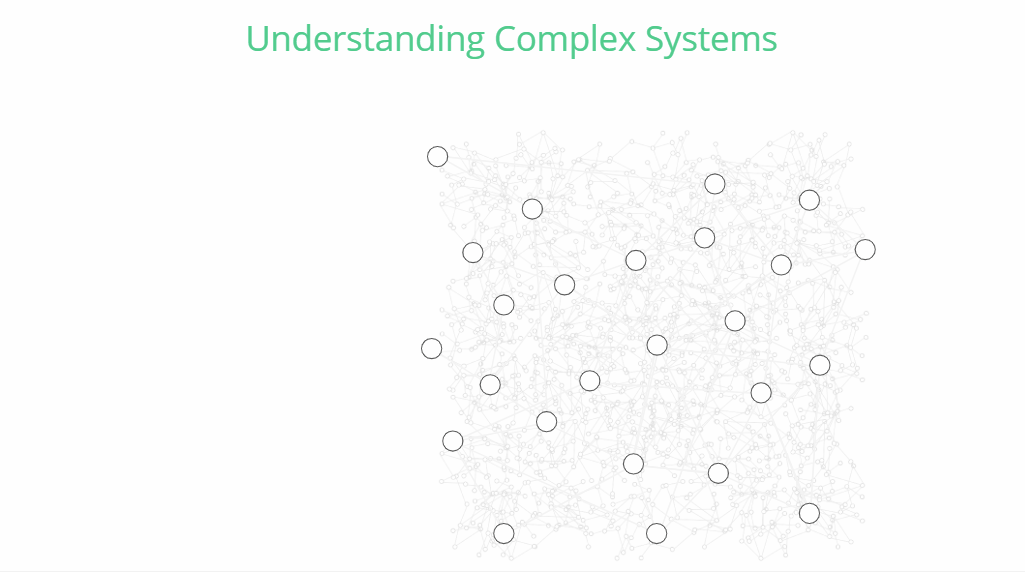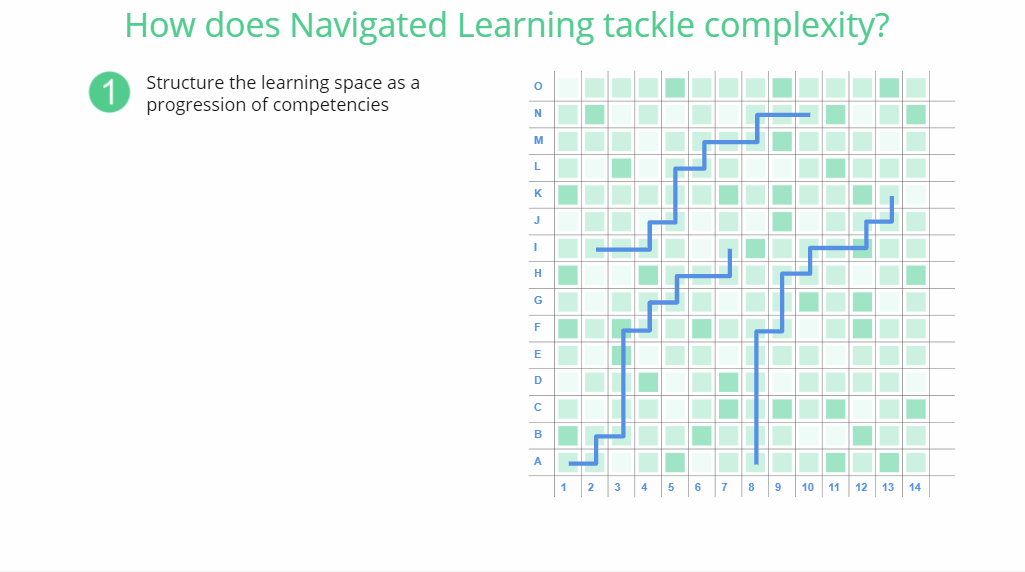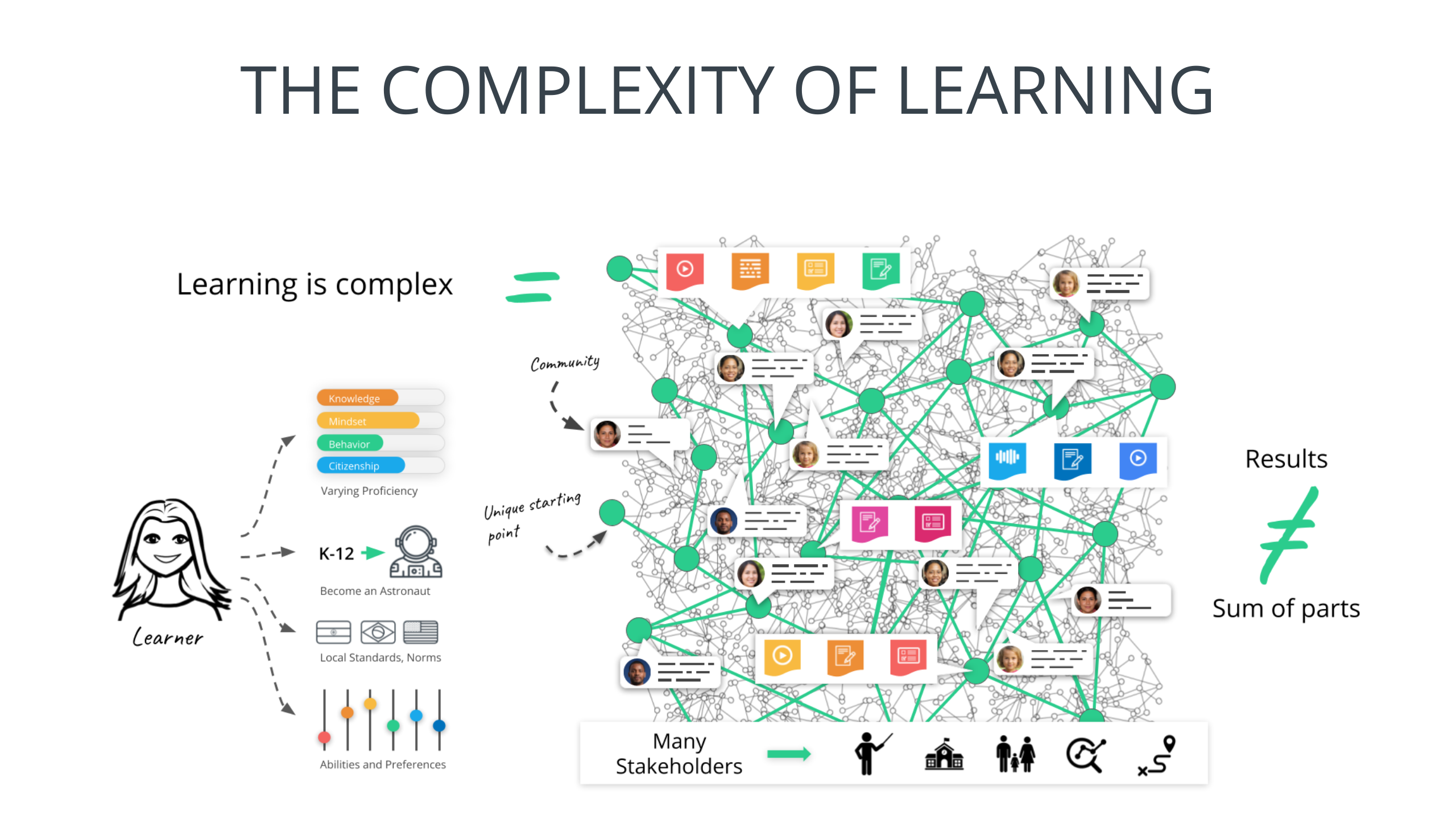Confront Learning Complexity with Elegance
Complex Learning Systems
Complexity is associated with the intricate inter-twining or interconnectivity of elements within a system and between a system and its environment. Causal effects are present in complex systems. In fact, there are so many causal interactions that interfere and feed back and forth, that it becomes hard to build simple, linear, causal models.
Overcoming societal challenges for a better world can be done by enabling lifelong learning worldwide. But, learning is complex with interrelated facets such as knowledge, mindsets, and behavior, interacting stakeholders such as parents, instructors, mentors, leaders, and interwoven learning resources and activities such as books, videos, simulations, VR experiences, projects, essays, and seminars.
All aspects of a learner’s environment — their home life, diet, sleep — and their personal characteristics– interests, self-confidence, and grit — combine to influence how they learn. They are also dependent on the nature of the educational system they participate in to provide them with instruction. Their learning is impacted by the variety of learning activities they use with content and tools including textbooks, interactive media, problems, projects, and essays. Learning outcomes are substantially influenced by the interventions of guardians, instructors, organization leaders, and educational content providers. We are “not one algorithm away” from transforming learning. Enabling strong learning outcomes requires a thoughtful approach to tackle the complexity and enable systemic change.
To move the needle in a complex learning system, we need to support collaborative efforts that can influence the emergence of the desired state, rather than simply launching an isolated process that generally results in unknown and often undesired outcomes.

The components can be individuals, teams, or autonomous system elements. The components in the case of social machines have “agency”, that is the function of each component operates on the inputs it receives from the interconnected components to produce an output. A characteristic property of agency is self-interest, which may be either fully or partially or not at all aligned with the intended function of the component. The function is not entirely predictable. This is in part because of the component taking agency and in part because we have not been able to model the function that the component implements. The component then shares its output with the other components as inputs to them. As a result, the overall complex system has a behavior that cannot be easily modeled. The economy, environment, human body, income distribution, global warming, etc. are all complex systems.
Confront Complexity with Elegance
All stakeholders supporting the learner and the learner themselves have a shared intent to accelerate learning gains. In a game-theoretic sense, this is a highly cooperative game where the learner, their parents, teachers, mentors, school leadership, and the adaptive algorithms all want the learner to succeed. We can tackle this complexity by providing the learner and all other stakeholders actionable insights based on real-time data about the learner’s knowledge, mindsets, and community engagement.
Navigated Learning is an approach that my colleagues and I have put together that tackles the complexity of learning by locating each learner in terms of their knowledge, mindsets, and community engagement with high precision and by providing personalized pathways to the learner and actionable insights to all other stakeholders. It provides the individual learner with an adaptive pathway of activities that continuously evolves based on performance so they can take agency in their learning. It provides appropriate feedback to all other stakeholders so they may use the actionable real-time insights to coordinate their support of the learner.
Navigated Learning locates every learner with precision and personalizes pathways for each learner based on their abilities, language of instruction, and access to technology. Navigated Learning locates every learner by capturing the data stream after every learning activity. It is designed for equity, learner variability, inclusion, scale, and diversity are absolute imperatives for a just world where everyone reaches their fullest potential for learning and livelihood. This approach works for everyone – students who have significant gaps, differently-abled, limited access to technology, are instructed in local languages, etc.
Navigated Learning locates every learner by capturing the data stream after every learning activity. Data after every event is associated with a competency, a learner, and the activity. This data stream can be processed with an analytics pipeline and AI to dynamically update the measures about the learner’s knowledge, mindsets, and community engagement.

Learners can be learning while doing job tasks, studying a course, or immersed in life events such as the pandemic, elections, and racial tensions. Each of these presents learning opportunities. Navigated Learning captures data after every learning activity whether it is from a job, curriculum, or life sequence, and updates learner understanding and curates the activities. These are then used to mediate pathways.

To tackle the social complexity around learning and enable systems change at scale, all stakeholders need to be provided with actionable insights based on real-time data about the learner. Learners obtain personalized pathways and this fosters learner agency. Other stakeholders get suggestions of appropriate interventions, so they can coordinate their support of the learner. Navigated Learning provides actionable insights to all stakeholders based on real-time data about the learner, so they together accelerate outcomes.

Leadership for a Thriving Ecosystem
Navigated Learning can be implemented by tapping into the collective intelligence of the ecosystem at large. Open ecosystems engender equity, by equally advantaging all learners. Different institutions focus on serving diverse learners. By enabling all practitioners in the ecosystem, we will reach all learners. The practitioners will range from schools, companies, nonprofits, government institutions across all disciplines of learning to reach every learner. Given the rapid changes in technology and the science of learning, we have to simultaneously engage a community of researchers who continually advance the art and science of learning and the community of developers that bring the latest technology has to offer.
Individual Success:
The ecosystem is invaluable because of its diversity. That also makes it challenging to enable individual success for every participant as they have distinct requirements and often different metrics of success. Researchers care about validated innovations, results that can support scholarly publications, and reaching a large number of learners with their research. Practitioners are hyper-focused on ease of adoption where they want to minimize the initial effort to practice Navigated Learning and subsequently on user delight that stems from engagement and efficacy. Understanding the different players in the ecosystem and supporting them to succeed, can bring about lifelong learning worldwide.
Collective Vigilance with Community:
All players in the ecosystem have a need to efficiently access information through information portals, and podcasts. They also want to seek and provide support on discussion forums and continuously dialog with experts such as practitioners, researchers, education stakeholders, and platform developers. Collective vigilance is also about engaging the many experts, both individuals both – individuals, and organizations, – across areas such as privacy, equity, standards, ethics in AI, technology, and community development itself.
Governance:
Governance has to pay particular attention to ensuring that the benefits of lifelong learning worldwide supports accessibility and promotes equitable and inclusive practices and learning environments. Privacy and Data security are paramount in any large-scale operations. Industry best practices to ensure that the learner’s activity data is not misused should be adopted to encourage learners to actively engage. To succeed, all partners unequivocally have to trust the plans and progress of the operations. Transparency in operations will engender trust.

